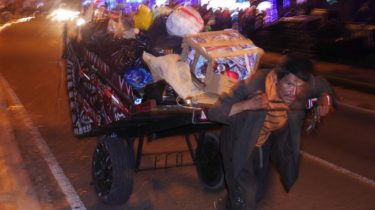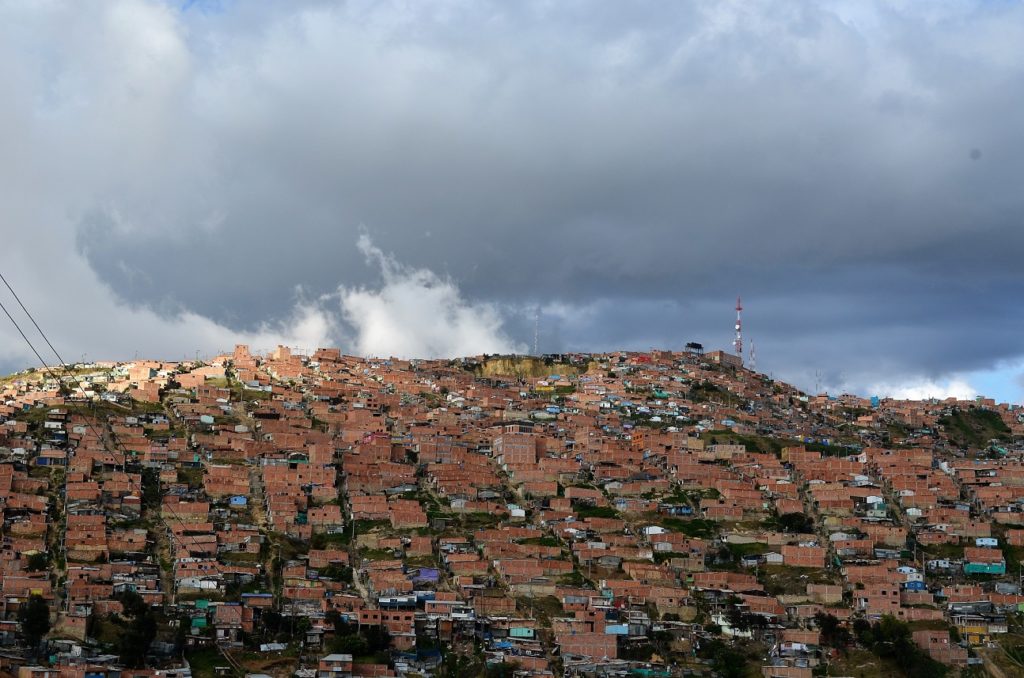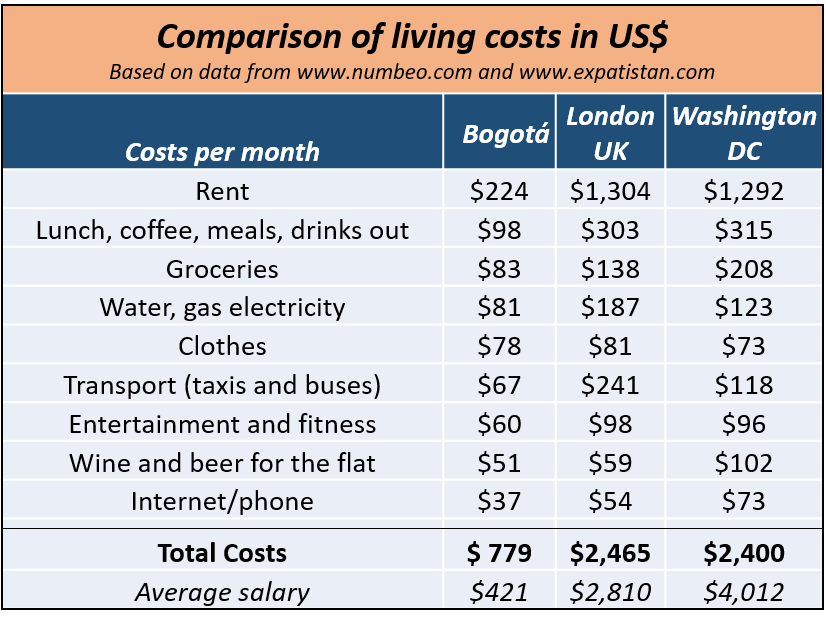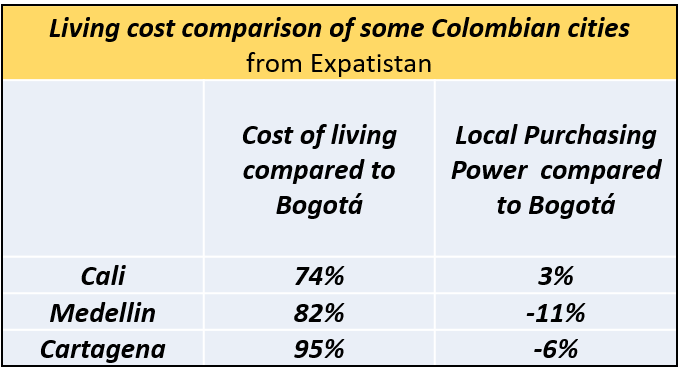Cost of living in Bogotá

by Steve Hide. This article first appeared in the Going Local column in The Bogotá Post, in June 2017.
How much does it cost you to live in Bogotá? Of course the question depends on who you are, and the notoriously fickle field of statistics, which I flunked at college years ago. Notwithstanding that (and perhaps finally to banish the ghost of my first failed Poisson distribution curve) I present my armchair-expert findings distilled from various websites and my own random survey in the local corner shop.

So let’s start with some assumptions. You are a single person in Bogotá, sharing a three-bedroom flat close to the city centre, having the occasional meal out with beers and some lunches in a local café, go to the movies every fortnight, the gym from time to time, buy a pair of jeans and new shoes every six months, drink a cappuccino every day, use local transport and a few taxis. You often cook at home, and have several beers and two bottles of wine a month. You work full time and earn the average wage.
So here’s the bad news: in Bogotá, you can’t. According to my calculations based on data from the website www.numbeo.com – which collects user-provided cost data from cities around the world – the above scenario will cost you US$779 a month in Bogotá. And your average salary will net you US$421. So to achieve this modest lifestyle you will have to earn nearly twice the average and even more if you want holidays, pets, a car or a family. And forget about saving for your own home. The chart below shows where your money might go, and compares it like with like for London and Washington DC.

OK, some of you might suggest to cut back on the drinks, meals out, gym, cinema and internet. But why? When we talk about ‘cost of living’, surely we mean ‘having a life’.
Stuck with mum and dad
These stats give insights into some social aspects of Bogotá, such as why adults still live with mum and dad, why so many Colombian want to move overseas, why Bogotá has so much crime and why the teachers (who earn just under the average salary) are always on strike.
It also explains that guilt wave we expat get every time you check out at the supermarket and realise your monthly grocery bill is higher than the monthly minimum wage, which at US$270 covers, to put it mildly, sod all.
Just to be sure I am not making all this up, there are other data sources we can check, such as the international Local Purchasing Power Index. This looks at the cost of living and local wages and takes New York as the benchmark at 100. Bogotá’s ‘LPP’ index is 37. That means the average rolo salary can afford to buy 63% less typical goods and services than New York City.
This puts Bogotá pretty low down on then index, in the bottom third with New Delhi, Bangkok and Lima.
Is Bogotá the problem? Are there other places in Colombia where the living is easy? Of course in rural areas people can grow food and be more self-sufficient, but face other problems like broken schools and no health posts. And other large cities are definitely cheaper than the capital. But here’s the rub: outside the Big B salaries are also lower. Crunching data from the Expatistan website give the following:

Smaller cities like Pereira, Popayan and Bucaramanga give similar results, which explains why, for all its hardships, Bogotá still attracts many people: more work opportunities and higher salaries (though there may be other compelling quality-of-life reasons to live in Colombia’s smaller cities).
The GINI in the bottle
Of course the sources for these stats are from websites use some data collected from people sending it in, so there will be bias. Other stats are more researched, such as the Gini Coefficient that measures the equality of wealth in a nation. If your Gini is 0 then you live in a utopia where everyone has exactly the same wealth and a Gini of 1 means one dictator owns everything in the whole country.
Not surprisingly countries with the lowest Gini are former socialist countries like Slovenia and the Czech Republic, and parts of Scandinavia, with GCs of around 0.25. The least equal countries are in sub-Saharan Africa and Latin America with scores of 0.5 and above.
Also not surprisingly is that Gini Coefficients are political papas calientes since they indicate just how much of a country’s wealth is being hogged by the rich few. In this sense Colombia fares badly with a GC of around 0.5, putting it in the bottom 20 basket-case countries along with places like Sierra Leone, Central African Republic and Honduras.
And if we look at the UN’s ‘Rich to Poor 10%’ salary ratio, Colombia does even worse. The latest figures (2013) suggest that the highest salaries are on average 60 times more than the lowest salaries. So some people earn more in one month than what the majority scrape together in five years.
Of course the endgame of this is not just poverty but conflict. Denied a living wage, it is hardly surprising some of the population turn to guns either to commit crime or for political ends (and sometimes both). During my various encounters with guerrillas over the years the first question in their interrogation manual was: ‘Do you know how much a farm worker gets paid?’
It is also about working conditions. Staff at private schools and colleges are often laid off a month before Christmas only to wait nervously until the following year to see if their contracts will be renewed. This also means the college can avoid paying the Christmas bonus. Even weirder is that everyone sees this as ‘normal’.
Suppressing the proletariat seems ingrained. Even my liberal-minded neighbours transform into petty dictators at the annual residents’ meeting when some small benefit is proposed for guy who cleans the building. The men round the table puff their chests out, talk down the motion, and compete to be the mano duro. The same happens each year on a national scale when Colombia’s politicians vote on the minimum wage raise and walk a tightrope between the workers and the bosses, but eventually screwing the workers.
Firm but poor
‘Steve, you foreigners have hearts that are too big,’ says a friend when we discuss this. ‘This is Colombia, you need to be firm. If you give workers an inch they will take a mile.’ But a few beers later he is bragging on his tax-avoidance scheme, then later moaning about economic stagnation, and finally asks his beer bottle: ‘Why can’t we be more like Germany?’

You don’t have to be a genius to figure out that raising the lower salaries in Colombia would solve many of its problems. If a large chunk of the population live below the bread-line who buys products and services? And wouldn’t paying a decent wage costs less than creating social services to prop up the poor?
And how often are we told that people grow coca ‘only because they can’t make any other living’. Then surely it is cheaper to up people’s wages than shoot at them from expensive helicopters when they go rogue and become cocaine cowboys.
Of course there are counter-arguments: that forcing up wages will break businesses and cause job losses. But often that’s not true. In fact companies that voluntarily up wages often get higher productivity, less absenteeism and less turnover of staff (which in itself is a big saving).
Will Colombia connect the dots? There is some
improvement: year on year the Gini is slowly – very slowly – going down. Wealth
distribution is on the political agenda. But some die-hard political families
will fight to the bitter end to keep playing Oligarchs and Peasants. There is still
some way to go.
Top Tips for Cutting Costs in Bogotá
Feeling the pinch? Here are some practical tips to cut costs on Bogotá.
Give up wine. Because of high import duty, a good bottle of Chilean wine costs around $55,000 (US$15) which is 30% more than the same product in Europe. So ditch the Casillero del Diablo (hard, I know) for a tot of tetrapack rum or a bottle of Poker.
Drink around the universities: students like drinking and are usually poor so the cheapest bars – and often the most lively – are around the university zones of the city (Chapinero).
Buy an old bicycle. The cheapest and quickest way round Bogotá is bicycle, the best being a used one you can get for around $75000 (US$22) from the compraventa (pawn shop) or from the bike repair shops which often sell on old bikes. By some chain and a padlock from the hardware store. You can buy yellow plastic capes in places like Homecenter.
Dump the gym membership. Now you have a bike, you will keep fit just moving around the city.
No more Mac attacks: A Big Mac Combo costs $18,000 (US$6) in Bogotá, OK that’s still cheaper than New York ($US8) but for the same cash you can get three corrientazos (see below).
Have the corrientazofor lunch. Fill up on wholesome home-cooked food by lunching on the $6,000 (US$2) ‘menu corriente’ – set menu – in Bogotá numerous small restaurants usually with a board outside announcing the day’s fare. You will get a wholesome soup, a meat-and-two-veg main course, a small pudding, and a glass of fresh made juice.
Learn Spanish for free: instead of buying classes, check out sites like language exchange sites (ie www.mylanguageexchange.com) where you can meet local’s learning your language. Everyone wins. You can skip the boring bits, like grammar, and get straight to the fun bit, like salsa.
Learn salsa: you’ll dance more and therefore drink less in clubs. Works out cheaper.
Shop in the fresh food market: if you are on a budget, supermarkets suck so check out MercadoPaloquemao (Calle 19 with Carrera 22) where thrifty rolosgo to do their weekly shop. You may need to haggle the prices.
Eat local food: Colombia’s bad roads mean high transport costs, so the cheaper food is grown closer to the capital, or just down the hill. Nearly all fresh vegetables are grown locally but many fruits (apples, pears, plums, kiwis) come from Chile and cost accordingly. Colombia’s tropical fruit (pineapple, papaya, bananas, passion fruit) are cheaper. Don’t forget the lesser-known Colombian fruits like zapote, nispero, lulo, guanabana etc.
Buy second hand: Bogotá is crammed with second-hand shops, from furniture to electro domestics to clothes to antiques. Small high-value stuff – cameras, computers, musical instruments, electric tools – can be found in the ubiquitous ‘Compraventa’ pawn shops. Websites such as www.mercadolibre.com.co have listings of stuff for re-sale. There are fascinating Sunday flea-markets on the Septima south of Av 26.
Move to a lower strata: Colombia’s eccentric estrata system zones neighbourhoods by wealth with Estrato 6 being filthy rich and Estrato 1 being just filthy. Officially services such as electricity, gas and water cost more in higher strata zones and, unofficially, everything else does too. A good compromise is Estrato 4.
Rent a room rather than a flat: There are many furnished rooms to rent, often with all services and internet included, which can be less costly than renting a flat. Close to colleges you can find cheap cupos universitarios – student digs with small single rooms and shared bathrooms and cooking areas.
